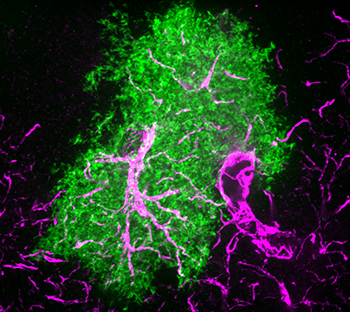Focus on the brain: RI-MUHC researchers address unmet needs in neurosciences
In the human brain and retina, glutamate is an important messenger that carries information from one neuron to another. The level of glutamate transmitted between neurons is crucial to cell communication: too high and neurons die, too low and the information is not communicated properly. In either case this can contribute to neurological diseases including stroke, glaucoma, and Alzheimer’s.

Dr. Don van Meyel
(Lead investigator)

Dr. Keith Murai
(Co-investigator)
The means to study glutamate are currently very limited but a new research team led by Dr. Don van Meyel, Director of the Centre for Translational Biology of the Research Institute of the McGill University Health Centre (RI-MUHC), has been awarded close to $1.5 million to develop a glutamate biosensor platform for brain diseases. The researchers, which include co-investigators Dr. Keith Murai (RI-MUHC), Dr. Adriana Di Polo (CHUM Research Centre) and Dr. Timothy Murphy (University of British Columbia), will exploit a revolutionary protein engineering technology called Cyto-iGluSnFR, allowing them to detect the glutamate levels that enter cells in the brain and retina.
This research project, along with five others across Canada, was awarded funding by the CQDM, Brain Canada and the Ontario Brain Institute (OBI) to address unmet needs in neuroscience within their Focus on Brain strategic initiative. The $10 million total funding announcement was made today at the annual meeting of the Canadian Association in Neuroscience being held in Vancouver.
"We are very thankful for the funding we received that will foster innovation in brain research," says lead investigator Dr. Van Meyel, who is also an associate professor in Neurology and Neurosurgery at McGill University. "By building a comprehensive platform for multiple stages of drug development and testing, our team of experts will accelerate progress toward new therapies for brain and eye diseases."

A brain astrocyte (green) showing its complex cellular morphology with its cytoskeleton (magenta)
Glutamate levels in the brain are precisely regulated by glial cells also called astrocytes that are located near neurons, through transport proteins on their surface called excitatory amino acid transporters (EAATs). The EAATs are very attractive targets for the development of new drug therapies.
"This funding will allow us to adapt the Cyto-iGluSnFR technology for targeting EAAT function and permit the screening of millions of chemical compounds in search of those that modulate these proteins," explains Dr. Murai, neuroscientist and associate professor in the Department of Neurology and Neurosurgery at McGill University. "These compounds could lead to the development of drugs allowing the modulation and restoration of glutamate flow into glial cells of the brain and retina."
"The excellent scientific team brought together under this innovative funding mechanism has the great potential to accelerate drug development by using this unique biosensor screening platform while providing important validation for the pharmaceutical partners to translate to new therapies for a variety of neurological diseases," adds Dr. Costas Karatzas, Director of Business Development Office at the RI-MUHC.
The six projects will unite 33 researchers from a dozen organizations in academia and small and medium-sized enterprises across Canada. Thanks to CQDM’s unique mentoring program, these researchers will also have the opportunity to collaborate with senior scientists from the pharmaceutical industry who bring industrial expertise and support to the projects, to help better align research with the needs of industry and patients.
Click here to read the national press release
More about the project
Glutamate the messenger whose flow of information is crucial in studies of brain diseases
Don van Meyel and Keith K. Murai (Research Institute-McGill University Health Centre), Adriana Di Polo (Research Centre of the Centre Hospitalier de l'Université de Montréal) and Timothy H. Murphy (University of British Columbia)
$1,416,375 / 3 years
The purpose of this project is to use a revolutionary protein engineering technology called Cyto-iGluSnFR and adapt it in order to discover new drugs leading to the treatment of a variety of brain and eye diseases. This innovative platform relies on a modified protein which allows the detection of glutamate levels that enter cells. Glutamate is an important messenger that carries information from one neuron to another, and the means to study it are currently very limited. Studying glutamate is important because its measurement and control can allow researchers to determine its effect on some neurological diseases such as stroke, glaucoma and Alzheimer's disease. Glutamate levels in the brain are precisely regulated by glial cells located in close proximity to neurons, through transport proteins on their surface called EAATs. The adaptation of the Cyto-iGluSnFR to these brain cells will allow the screening of millions of chemical compounds that will lead to the development of drugs that will effectively target the EAATs, allowing the modulation and restoration of glutamate flow into glial cells, required for proper brain function.
-30-
Julie Robert
Communications Coordinator – Research
Public Affairs & Strategic planning
McGill University Health Centre
514 934-1934 ext. 71381
facebook.com/cusm.muhc | @cusm_muhc
cusm.ca|rimuhc.ca
